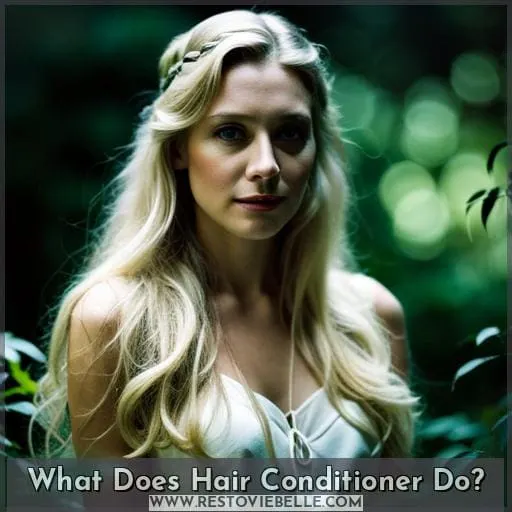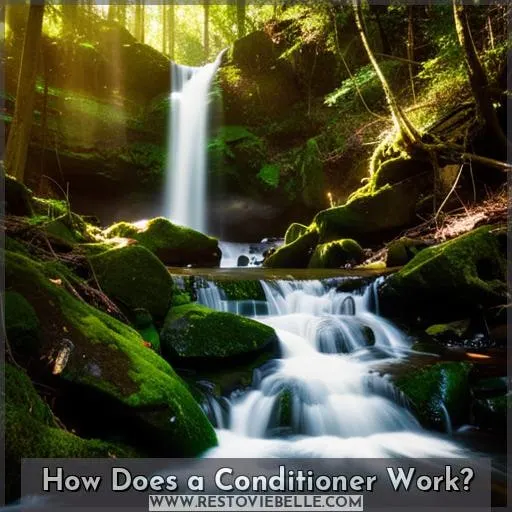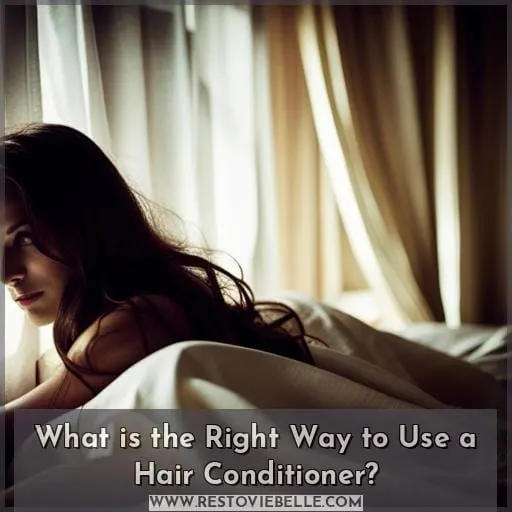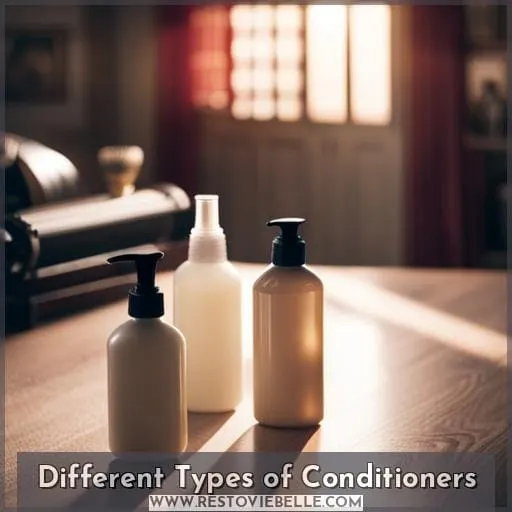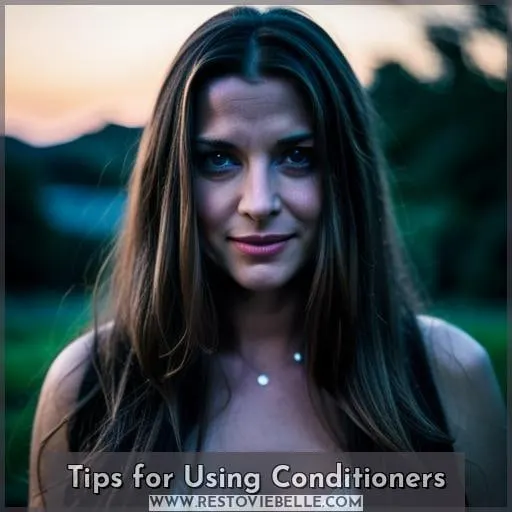This site is supported by our readers. We may earn a commission, at no cost to you, if you purchase through links.
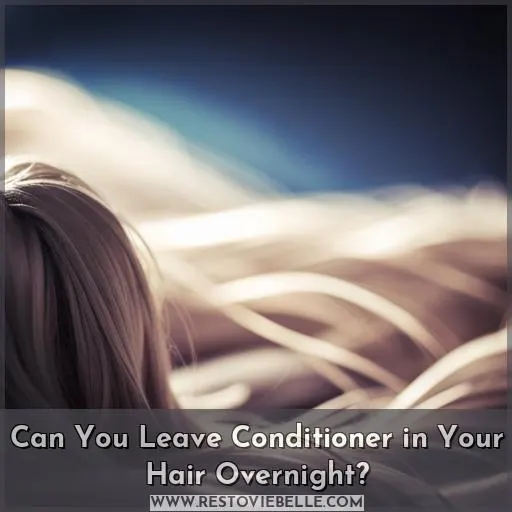
To get the most out of this product, let’s take a look and see what happens if you leave conditioner in your hair for too long. From how these products work to different types available on the market today – there are so many things to consider when using them correctly.
We’ll cover everything from how often you should use them to tips on getting the best possible results! By understanding why we need conditioners and how they work together with other styling products, we can help ensure healthy-looking strands all year round.
This way, we can avoid leaving any residue behind or causing scalp irritation due to overuse or wrong application technique.
Table Of Contents
- Key Takeaways
- What Does Hair Conditioner Do?
- How Does a Conditioner Work?
- Can You Leave Conditioner in Your Hair Overnight?
- What Happens if You Leave Conditioner in Your Hair?
- What is the Right Way to Use a Hair Conditioner?
- How Frequently Should You Apply Conditioner?
- Different Types of Conditioners
- Tips for Using Conditioners
- Conclusion
Key Takeaways
- Leaving conditioner in your hair overnight can lead to product buildup, weakened strands, and scalp irritation.
- It is important to apply conditioner sparingly to avoid these risks and test for allergies before use.
- There are different types of conditioners, including leave-in, rinse-out, and deep conditioners, each with their own benefits and precautions.
- Overall, proper conditioner use can result in stronger, healthier, and shinier hair.
What Does Hair Conditioner Do?
You can improve moisture, shine, and overall hair health with the right conditioner that contains nourishing ingredients like oils, silicones, and emollients. Conditioning your hair regularly allows you to maintain a healthy balance of moisture in your scalp while also protecting it from environmental damage or breakage.
When left in overnight, however, rinse-out type conditioners may cause problems such as product buildup on the scalp or weakened strands due to residue build-up. This can lead to split ends or damaged cuticles. To maximize benefits without any issues arising, use only small amounts of leave-in conditioner for hydration and detangling every 2 weeks (more frequently if oily).
Follow this up with deep conditioning treatments 2-3 times per week before styling with a heat protectant spray.
Choose sulfate-free products that are safe enough for all types of hair. These products should contain proteins, keratin oil, humectants, etc., ensuring maximum protection from sun exposure while preventing frizziness and breakages at the same time! With proper care and maintenance, you’ll be able to enjoy soft, supple locks full of bounce and vitality.
How Does a Conditioner Work?
Conditioners are essential elements of any hair care routine, but simply applying one may not be enough. To make sure you’re getting the most out of your conditioner, it’s important to understand how it works and why certain ingredients are included in its formula.
First off, let’s take a look at what happens when we apply a conditioning product. When applied correctly (from mid-lengths to ends, avoiding the scalp), conditioners penetrate through each strand of hair and form an outer layer over the cuticle.
This helps retain moisture within our strands while also providing added protection from environmental damage. The temporary protective barrier created by the conditioner helps prevent breakage due to friction or heat styling tools like blow dryers or flat irons.
In addition, many leave-in formulas contain beneficial ingredients such as proteins, keratin oils, and humectants.
Ingredient insights aside, leaving a rinse-out type of conditioner overnight is not recommended. This could potentially lead to problems such as product buildup on the scalp or weakened/irritated hair over time.
Frequent usage without proper washings between applications could result in split ends and damaged cuticles eventually. It’s important to take breaks every couple of weeks depending on individual’s specific needs and desired results (e.
Luckily, there are special leave-in versions specially created for extended use. This means that even those who don’t have time to perform daily routines can still enjoy the long-term effects of conditioning their hair!
Can You Leave Conditioner in Your Hair Overnight?
Leaving a rinse-out conditioner in can cause product buildup, weakened strands, and scalp irritation. But with proper application of an overnight formula, you may be able to reap the benefits while avoiding potential risks.
Overnight conditioning products are designed for extended use and provide deep hydration that works throughout the night to improve hair health. While there are leave-in conditioning products available for daytime use as well, using them overnight offers more intensive care, leading to better results in terms of hair moisture and overall health.
When choosing an overnight conditioner, make sure it is suitable for your specific hair type or concern. Avoid harsh chemicals like sulfates or parabens. Cover your head with a shower cap before going to bed.
What Happens if You Leave Conditioner in Your Hair?
If you leave conditioner in your hair overnight, it can cause product buildup and scalp irritation. This can lead to weakened hair, split ends, breakage, and damage to the cuticle of the strands.
Product Buildup
If left on the hair too long, product buildup can lead to weakened strands and scalp irritation. For instance, Neutrogena Oily Hair Scalp Conditioner may block pores if not rinsed out after each use.
With an overnight conditioner routine in place for hair damage prevention, a morning care ritual is necessary to avoid long-term effects of product accumulation.
Proper conditioning allows you to reap the benefits while still keeping away from potential pitfalls like breakage or dryness due to over-conditioning.
Scalp Irritation
Leaving conditioner in your hair overnight can result in scalp irritation. To avoid this, researching options and proper technique is key to a healthy scalp. Proper application, considering allergies, and avoiding excess residue are all part of a successful scalp care routine.
Overnight benefits can be achieved with the right product for an individual’s hair type. From deep conditioning to leave-in protectants, there are products specifically designed for extended use on any hair type or texture.
Take into consideration proper techniques when applying these treatments. Wet the strands first, avoid direct contact with the scalp, use sparingly based on the length and thickness of your locks, and cover it up during the treatment process.
These steps will help maximize potential results without irritating the skin underneath.
Grimy Residue
You risk developing a grimy residue on your hair if you don’t properly remove conditioner. Excess product left in the hair overnight can lead to buildup, which often causes dryness, breakage, and split ends.
To avoid this issue, make sure you rinse out all of the conditioner after each use and follow up with a clarifying shampoo every few weeks to ensure there is no residue buildup.
Lastly, be sure to stick with a regular cleansing routine that suits your individual concerns for optimal results without any unwanted side effects like grimy residues!
What is the Right Way to Use a Hair Conditioner?
Using a hair conditioner is an important part of your overall hair care routine. It can help to protect and nourish your hair, improve its texture, and reduce breakage due to dryness or environmental factors.
To get the most out of using a conditioning product, it’s important to know how much you need for your individual needs as well as when and where you should apply it – including if you’re considering leaving some in overnight.
Use It From Your Midsection to the Ends of Your Hair
Gently apply conditioner from the midsection of your hair to the ends, like a smooth river of nourishment. This helps ensure even hydration and prevents breakage, while allowing you to take advantage of overnight benefits such as increased repair and shine.
When using an overnight conditioner, be aware that there are risks involved, including product buildup or weakened hair over time.
Use the Suggested Amount
Apply the right amount of conditioner for your hair type to get the best results. Too little won’t provide enough hydration, while too much can lead to product buildup and damage. Depending on your hair thickness and length, use the suggested amount that gives moisture balance without weighing it down or damaging it overnight.
Don’t forget allergy testing before using any new conditioners—it’s worth checking ingredients! Proper application is key; follow instructions carefully for optimal results when you leave the conditioner in your hair overnight.
Test Conditioner Ingredients on Your Skin Before Use
Before using any new conditioner, it’s important to test its ingredients on your skin like an artist testing a paintbrush. This will help you identify ingredient allergies and prevent unpleasant reactions.
- Patch Test – Apply a small amount of product to the inside of your elbow or wrist area and wait 24 hours for signs of redness or itching.
- Skin Testing – Use diluted amounts on other areas, such as behind the ear, before applying all over your hair and scalp.
- Sensitivity Testing – Observe real-world scenarios by using more diluted products in several applications until you fully understand how each performs with no risk of irritation.
- Allergic Reactions – If any negative reaction occurs during use, discontinue immediately. Consider consulting with a doctor if necessary before introducing it into your hair care regimen.
How Frequently Should You Apply Conditioner?
Depending on your hair type, you should condition your locks every 2 weeks for regular hair or 2-3 times a week for oily strands. Proper application frequency is essential to ensure the health of your tresses and keep them looking their best.
Here are some tips:
- Start by adding a small amount of conditioner in the midsection and ends only, avoiding contact with the scalp altogether.
- Use heat protectant sprays before styling as an added layer of protection from environmental damage due to sun exposure and humidity levels.
- After conditioning, cover up with a shower cap or towel wrap for deeper penetration into each strand if desired – this will help improve nourishment even further!
With proper application frequency comes improved hydration, strength, detangling capabilities, as well as reduced friction that can lead to breakage over time – all vital components towards maintaining healthy hair strands long term!
Different Types of Conditioners
When it comes to conditioning your hair, there are three main types of conditioners you can choose from: leave-in, rinse-out, and deep conditioners. Leave-in conditioners provide hydration and detangling for the hair without having to be washed out.
Rinse-out conditioners are generally used after shampooing, while deep conditioning is best suited for more intensive treatment, particularly on curly or color-treated locks.
Leave-in Conditioners
Discover how leaving a leave-in conditioner in your locks can give you dreamy, full hair with incredible shine. Leave-in conditioners protect tresses from heat and sun damage while providing overnight hydration for softness and manageability.
Choose the best brand for your hair type to avoid scalp itchiness or product buildup. Application tips? Wet clean strands before applying to the midsection and ends, avoiding the roots; check ingredients for allergies; cover your head while conditioning! Reap all the benefits of leave-in conditioner – increased moisture retention, improved strength, and detangling – without causing breakage or split ends due to overconditioning.
Rinse-Out Conditioners
Rinse-out conditioners lock in moisture, improve shine, and reduce breakage. Overnight benefits include avoiding product accumulation and protecting the hair shaft, while risks involve potential scalp irritation.
Long-term effects may lead to split ends or damage to the hair cuticle. Proper application techniques vary by the type of conditioner; apply from the midsection down on wet hair, avoiding the scalp area for best results.
Alternative methods like deep conditioning can provide additional protection, with sulfate-free shampoo prepping before use for maximum follicle health benefits.
Deep Conditioners
Deep conditioning can provide intensive treatment to those with curly or color-treated hair, offering proteins, keratin, and oils for enhanced strength and detangling. Overnight deep conditioners are a great option for repairing damage due to heat styling.
When selecting a product, look for natural ingredients that offer benefits such as hydration, humidity control, frizz reduction, and shine enhancement.
To apply, wet the hair first before applying from the midsection of the strands down toward the ends, avoiding the scalp area.
Products available range from budget-friendly options like Monday Haircare Volume Conditioner to more expensive brands like Neutrogena’s Oily Hair Scalp Conditioner, which is paraben-free and ideal for all types of hair, including color-treated tresses.
Tips for Using Conditioners
Using conditioners is a great way to improve the health of your hair, but it’s important to understand which type of conditioner works best for you. Rinse-out conditioners are used after shampooing and can help protect from sun exposure and heat styling; leave-in conditioners provide hydration and detangling without causing loss; deep conditioning treatments target curly or color-treated hair for intensive treatment.
Knowing how to choose the right product, apply it correctly, and use it at the right frequency will ensure healthy locks with lasting results.
Tips for Using Rinse-Out Conditioners
For fabulous follicles, use rinse-out conditioners regularly to refresh and revitalize your tresses. Wet your hair before application and avoid the scalp. Test the ingredients for allergies. Apply from the midsection to the ends; the frequency depends on the type of hair.
Cover with a shower cap for deeper penetration, then rinse thoroughly—avoiding buildup that can lead to weakened strands or irritation! Select products wisely: read labels and reviews carefully, avoiding sulfates and parabens when possible.
Tips for Using Leave-in Conditioners
Try using leave-in conditioners to keep your hair healthy and hydrated throughout the day. The benefits of these products are numerous. They can strengthen and detangle strands, protect against sun exposure, heat styling damage, and split ends.
For overnight application, choose a product that is free from sulfates or parabens and is suited for your hair type – oily or dry.
When selecting a product, look out for ingredients like proteins, keratin oils, and humectants.
With proper use, you’ll enjoy all the benefits of leave-in conditioner without sacrificing hair health in the process!
Tips for Using Deep Conditioners
To give your hair the extra nourishment it needs, try deep conditioning for an intensive treatment. Benefits include repair, moisture-locking, and protection from damage. Apply conditioner to wet hair, avoiding the scalp area; leave it on overnight or for 20 minutes before rinsing out with lukewarm water.
Look for quality ingredients like proteins and keratin to help restore shine and elasticity in damaged locks.
Conclusion
It’s no surprise that conditioners have become a beauty staple, considering the multitude of benefits they provide. To reap the full benefits of a conditioner, it’s important to use the right product and technique.
While leaving a rinse-out conditioner in your hair overnight may seem like a tempting way to get an extra dose of hydration, the truth is that it can result in product buildup, weakened hair, and scalp irritation.
Instead, apply conditioner to the midsection to ends of wet hair and use the recommended amount for your hair type and length.
With the right type and frequency of conditioner, you can enjoy stronger, healthier, and shinier hair.

